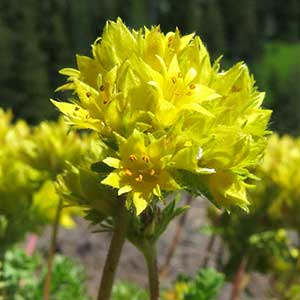Ivesia gordonii
Ivesia cryptocaulis
alpine ivesia, alpine mousetail, Gordon's ivesia
Charleston Peak ivesia, Charleston Peak mousetail
prostrate to erect, (0.2–)0.5–4 dm.
prostrate to decumbent, 0.2–0.6(–1) dm.
tightly to loosely cylindric, (1–)3–20(–25) cm; sheathing base ± glandular abaxially, otherwise glabrous;
petiole 0.5–8 cm, hairs 0.2–0.5 mm;
leaflets (6–)10–25 per side, (1–)2–13(–18) mm, glabrous or ± hirsute or villous, glandular-puberulent or -pubescent, lobes (2–)4–8(–15), linear or narrowly oblanceolate to obovate, apex rarely setose.
tightly cylindric, 1–4(–5) cm; sheathing base mostly not strigose abaxially;
petiole 0.3–2 cm, hairs 0.5–1 mm;
lateral leaflets 5–10(–12) per side, ± overlapping, ± flabellate, 1–2.5 mm, incised to base or nearly so into 3–5 obovate to oval lobes, apex sometimes ± setose, surfaces loosely long-strigose, sparsely glandular;
terminal leaflets indistinct.
1(–2), not paired.
1(–2);
blade vestigial.
5–50(–70)-flowered, 1–8(–11) cm diam.;
glomerules 1–several.
1–10-flowered, ± congested, 0.5–1.5 cm diam.
1–3(–5) mm.
3–7(–10) mm.
5–12 mm diam.;
epicalyx bractlets linear to narrowly elliptic, (0.5–)1–3.5(–4) mm;
hypanthium turbinate to campanulate, (1.5–)2–4(–4.5) × 2–4(–5) mm;
sepals (2–)2.5–5(–6) mm, obtuse to ± acute;
petals yellow, narrowly oblanceolate to narrowly spatulate, (1–)1.5–3 mm;
stamens 5, filaments 1.3–2.5 mm, anthers yellow, sometimes red-margined, 0.5–1 mm;
carpels (1–)2–4(–6), styles 2.5–4.5(–6) mm.
6–9 mm diam.;
epicalyx bractlets 5, lanceolate to narrowly oblong or narrowly ovate, 0.8–1.3 mm;
hypanthium shallowly cupulate, ± 1 × 2–3(–4) mm;
sepals 1.5–2.3 mm, ± acute;
petals yellow, oblanceolate to spatulate, 2–3.2 mm;
stamens 5, filaments 0.9–1.2 mm, anthers yellow, oblong, 0.7–0.9 mm;
carpels 6–10, styles 1–1.5 mm.
grayish brown to mottled brown, ± 2 mm.
greenish cream to light brown, 1.4–1.8(–2) mm, smooth, not carunculate.
Ivesia gordonii
Ivesia cryptocaulis
Varieties 4 (4 in the flora).
Ivesia gordonii is the most widespread species of the genus, occurring from Washington to Montana, south to central California and Colorado. The species can be distinguished from other members of sect. Ivesia by the relatively deep hypanthium, which is about as deep as wide. Four varieties are provisionally recognized here (B. Ertter and J. L. Reveal 2007), with the likelihood that future work may indicate additional and/or alternate circumscriptions. Populations that are difficult to assign to a variety can be found where the recognizable taxonomic units come together, for example, in northeastern Utah and western Wyoming, involving var. gordonii and var. wasatchensis, and in California and central Idaho where var. alpicola and var. ursinorum tend to merge.
(Discussion copyrighted by Flora of North America; reprinted with permission.)
Of conservation concern.
Ivesia cryptocaulis is known only from timberline and above in the Spring Mountains of Clark County. Plants differ from all others of the genus by having slender, elongate, diffuse caudex branches that ramify through its habitat of gravel, scree, and talus. The species is here provisionally included in sect. Setosae as a diffusely matted relative of I. shockleyi (as also suggested by D. D. Keck 1938); the ecarunculate seeds and relatively straight pedicels may indicate a greater similarity to I. pygmaea in sect. Ivesia.
(Discussion copyrighted by Flora of North America; reprinted with permission.)
1. Leaflets 7–13(–18) mm, glabrous or sparsely hirsute or villous marginally; stems (1–)1.5–4 dm; inflorescences usually branched, 2–8(–11) cm diam., glomerules (1–)2–6(–10), ± capitate. | var. wasatchensis |
1. Leaflets (1–)2–7(–9) mm, hairy or ± glabrous except marginally ciliate; stems (0.2–)0.5–2.5 dm; inflorescences simple or branched, 1–3(–5) cm diam., glomerules 1(–3), ± capitate to loosely congested | → 2 |
2. Stems usually prostrate to ascending, rarely nearly erect, usually dark reddish, minutely glandular or glandular-puberulent to -pubescent; leaves to 0.8 cm diam.; anthers usually red-margined. | var. ursinorum |
2. Stems usually ascending to erect, sometimes decumbent, usually greenish, rarely reddish, hirsute to villous, glandular-puberulent to -pubescent; leaves to 1.5 cm diam.; anthers rarely red-margined | → 3 |
3. Stems usually hirsute to villous, sometimes densely so, glandular-pubescent or eglandular; basal leaves (3–)5–10(–15) cm; flowers 7–12 mm diam.; e Idaho and w Montana to Utah, Wyoming, and w Colorado. | var. gordonii |
3. Stems not or sparsely hirsute to villous, glandular-puberulent or -pubescent; basal leaves 2–8(–10) cm; flowers 5–9 mm diam.; s Washington to California and e to w Montana. | var. alpicola |


